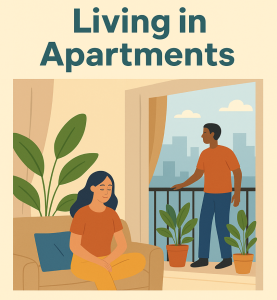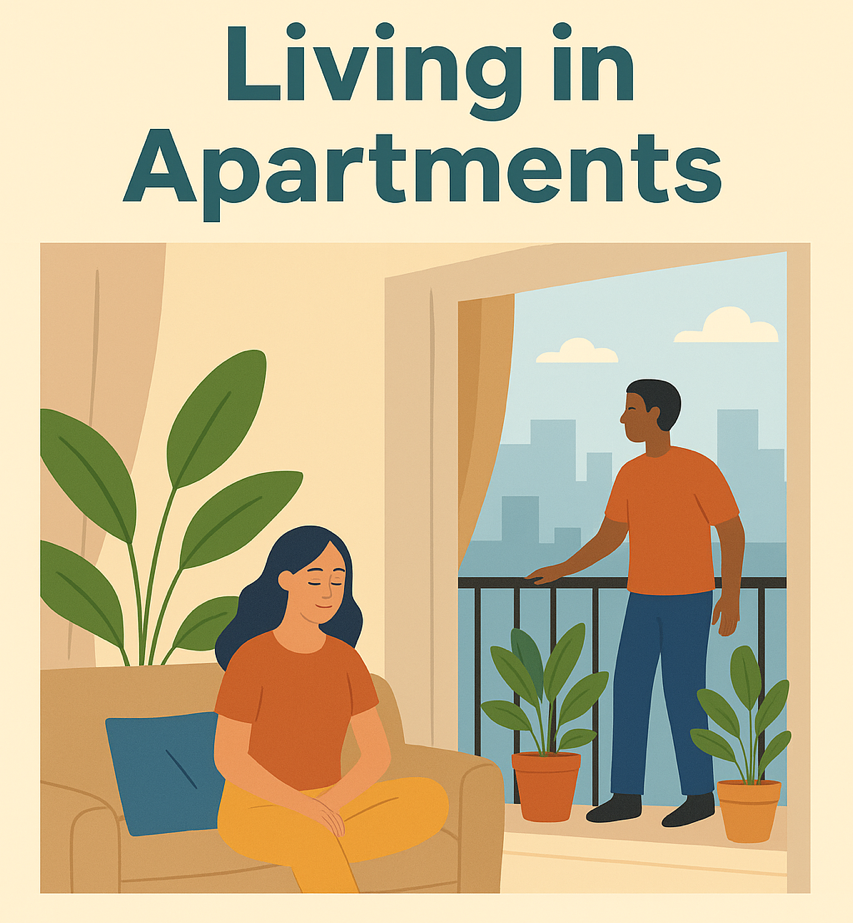
Living in Apartments: Strategies for Creating a Sense of Calm and Intimacy, Managing Noise, and Designing Green Spaces on Balconies
Abstract
Apartment living has become a dominant feature of modern urban life. While it offers advantages such as accessibility to amenities and improved security, it also brings challenges like noise, limited personal space, and reduced social interaction. This article explores practical strategies for creating a sense of calm, intimacy, and well-being in apartment environments. It also examines methods of noise management and the integration of balcony green spaces as tools to enhance psychological comfort and urban livability.
Introduction
Rapid urbanization has transformed residential patterns worldwide. As cities expand and land becomes scarce, apartment living has emerged as the main form of urban housing. In this lifestyle, residents share limited spaces where maintaining comfort, harmony, and healthy relationships requires thoughtful planning.
The quality of life in such environments depends largely on interior design, social etiquette, and environmental factors such as sound control and greenery. Integrating these aspects can foster tranquility and a sense of belonging among apartment dwellers.
Section 1: Creating a Sense of Calm and Intimacy in Apartment Living
- Interior Design through Color and Light
Soft colors such as white, light blue, and pastel green reduce stress and promote relaxation. Natural light also plays a crucial role in creating a peaceful atmosphere. - Smart Space Division
In smaller apartments, using shelves, curtains, or sliding partitions instead of solid walls creates an open and breathable layout. - Human Connection among Neighbors
Building friendships through short gatherings, shared building responsibilities, and mutual respect contributes to community harmony. - Personal Retreat Corners
Creating small personal zones with plants, comfortable seating, and warm lighting helps residents recharge and feel emotionally secure.
Section 2: Noise Management in Apartments
- Acoustic Insulation
Installing soundproof panels, double-glazed windows, and soft flooring (such as carpets and rugs) significantly reduces noise transmission. - Community Awareness and Etiquette
Educating residents—especially children—about quiet hours and respecting shared spaces is vital for collective comfort. - Functional Layout Planning
Bedrooms should be placed away from elevators, staircases, or public corridors to minimize exposure to external noise. - White Noise and Relaxing Sounds
Playing soft nature sounds or calm instrumental music can mask unwanted noise and improve sleep quality.
Section 3: Designing Green Spaces on Balconies
- Selecting Suitable Plants
Plants such as geraniums, pothos, ferns, and succulents thrive well in limited spaces and require minimal maintenance. - Vertical Gardening
Using vertical planters or hanging pots maximizes the use of small balconies while enhancing aesthetics. - Soft Lighting for Evening Ambience
Warm or solar-powered lights integrated among plants create a cozy and inviting atmosphere at night. - Combining Nature with Minimal Furniture
A small table and two chairs surrounded by greenery can turn any balcony into a peaceful personal retreat. - Psychological Benefits of Greenery
Studies show that exposure to plants reduces anxiety, increases positive emotions, and improves overall well-being.
Conclusion
Apartment living can be both comfortable and fulfilling when proper design, social engagement, and environmental awareness are prioritized. Integrating nature into living spaces, controlling noise, and fostering community bonds transform apartments from mere physical shelters into nurturing, harmonious environments. True serenity in apartment life stems not from material comfort but from the balance between individual and communal well-being.
References
- Hosseini, M. (2021). Environmental Psychology in Residential Spaces. University of Science and Technology Press.
- Delavar, K. (2020). Principles of Interior Design for Small Urban Spaces. Faza Publications.
- Kaplan, R., & Kaplan, S. (2011). The Experience of Nature: A Psychological Perspective. Cambridge University Press.
- Evans, G. W. (2003). The Built Environment and Mental Health. Journal of Urban Health, 80(4), 536–555.




